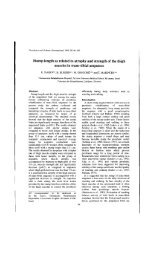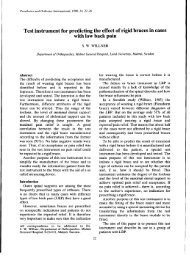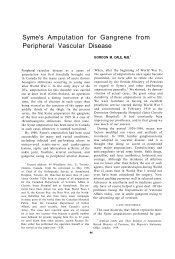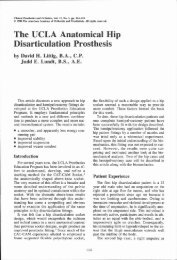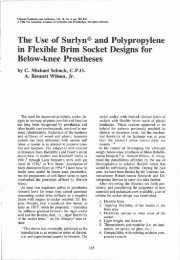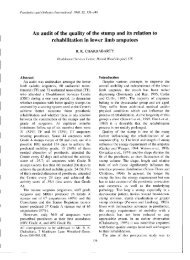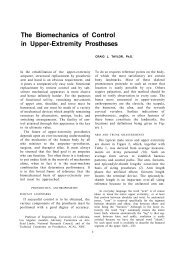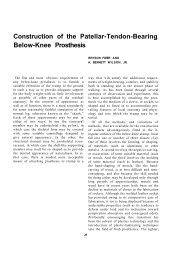Pro-Corn - O&P Library
Pro-Corn - O&P Library
Pro-Corn - O&P Library
Create successful ePaper yourself
Turn your PDF publications into a flip-book with our unique Google optimized e-Paper software.
characteristic of the material has not proven to<br />
form a dependable bond in these sandals.<br />
Then cut the #2 piece to the edge of the # 1<br />
piece and ground both pieces vertically to meet<br />
the line drawn earlier. At this time, ground flat<br />
some of the roundness on the plantar surface of<br />
the molded #2 piece and flatten by grinding the<br />
area under the metatarsal heads and toes.<br />
Use the 1 1/2" wide webbing to build the strap<br />
which will cross over the midfoot region just in<br />
front of the ankle. Use the 1" webbing for the<br />
strap which will cross over the top of the metatarsals<br />
just proximal to the metatarsal heads.<br />
Also use 1" strapping behind the heel.<br />
Place the patient's foot in the foot bed and<br />
"velcro" the straps together and hold them in<br />
place over the foot. Align the straps over the<br />
foot and mark the Plastazote® and straps<br />
(Figure 4). Glue together the Plastazote®<br />
footbed and straps, using the marks as a reference.<br />
Cut the straps under the sandal so they<br />
don't overlap (Figure 5).<br />
Coat with glue the 5" x 10" x 1/2" scrap<br />
piece of #2 Plastazote® and the bottom of the<br />
molded footbed and heat the #2 piece. Glue<br />
the #2 piece under the heel arch and metatarsal<br />
heads. Ground down the bottom to form a 1/2"<br />
high wedge heel which tapers down to the<br />
metatarsal heads (Figure 6). This heel lift also<br />
serves to fill any remaining arch and curvature<br />
under the sides of the molded footbed.<br />
The sole of these sandals should be absolutely<br />
rigid. On smaller patients the rigid Plastazote®,<br />
which will be added later, will be sufficient<br />
to accomplish this. But in larger,<br />
heavier patients, it may be necessary to include<br />
a rigid steel shank from the heel to the toe. For<br />
those patients, glue a piece of leather to the<br />
bottom of the footbed to prevent penetration of<br />
the steel through the footbed. Bend up the steel<br />
from the metatarsal heads to the end of the toe<br />
of the sandal in the form of a rocker. Glue the<br />
steel shank to the bottom of the leather, and<br />
shape and grind flat a filler material around the<br />
shank so bumps will not form in the outer sole<br />
of the sandal.<br />
If the steel shank is not used, coat with glue<br />
a piece of 5" x 12" x 1/4" rigid #3 Plastazote®<br />
and the bottom of the footbed. Heat the #3<br />
piece and then attach it to the bottom of the<br />
footbed. This is done by adhering the heel of<br />
the sandal to the #3 piece first and then, in a<br />
rolling motion, elevate the heel of the sandal as<br />
the toe is pressed down onto the material piece<br />
(Figure 7). This creates a rocker sole with increased<br />
toe spring under the toes.<br />
Skive back one end of a piece of rigid Plastazote®<br />
3" wide by 33" long and 1/4" thick to a<br />
distance of 2" and at a shallow angle. Then<br />
apply glue over the 2" skived portion and the<br />
entire other side of the rigid Plastazote® piece.<br />
Coat the sides of the footbed with glue. Heat<br />
the rigid Plastazote® and glue it vertically<br />
around the perimeter of the sandal (Figure 8).<br />
Glue the skived end to the medial arch area of<br />
the footbed first. This leaves the glue coated<br />
skived area facing out from the sandal. Completely<br />
wrap the #3 strip around it, overlapping<br />
onto the skived area, and cut off the excess.<br />
Trim the bottom flat and round the upper edge<br />
Figure 6. The bottom of the sandal is ground flat under heel, arch, and metatarsal heads after the heel<br />
wedge is glued on. The area under the toe is ground up to form the rocker.



